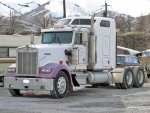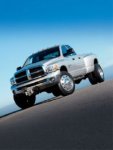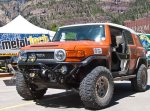I partially agree the front will wear a lil more. But would think other compents in the steering, ball joints/kingpins would wear faster than the bearings in the hubs on the front. I may have misunderstood but thought we were discussing bearing wear on the front.
Im still not understanding why the OP would even want to consider running them dished out on the front! Cool factor, not really in my opinion. After market wheels with more offset are available but still safer to use than saving money and flipping the fronts.
I totally understand now, thanks to Doghead & others.
The reason I asked is because I'm new to large trucks. I've been around 4x4's for ages but have only had a Deuce for a year.
I'm making mine into an off-road RV. I'm a geologist, occasional fossil hunter, and avid outdoor enthusiast. I go places that I shouldn't go. But I go there anyway for days on end.
So I want to build a more comfortable "expedition" vehicle based on the Deuce.
I've watched every Deuce video available on YouTube. For the money, I think this truck is an awesome platform to start from. But, like anything in life, there is room for personal improvements to suite your needs.
One thing that I noticed on the YouTube videos is the Deuce's front tires seem too narrow in stance on hummocky, downhill rough trails. This may not necessarily result in flipping the truck. But lodging it sideways on a rock & catching a fender is not a joyful scenario either. It would be nice to have a slightly wider stance up front.
In my state the maximum width is 102" with an extra 3" for pneumatic tires & mirrors. So, 108" is the state vehicle width. Some municipalities have a 96" restriction. To make a long story a little shorter, I was curious if the front stance could be widened to aid in stability. The truck is going to be lifted to accommodate larger tires. That will put the center of gravity higher. A wider stance would be beneficial.
Also, I've had a wild-hair-up-bum idea if it's possible to have tandem-rear steer axles. My projected wheelbase using an M36 frame is about 240". That's almost identical to a 40' motorhome. While certainly drivable, I can already well imagine off-road situations where a 240" wheelbase could be, shall we say, less than optimal. But if a stock bogie-axle setup is used, the leaf springs would not allow the rear tires to turn much before rubbing. Deep dish rims on rear-steer axles would allow front axles to be used in the rear without rubbing issues. Now, I'm not saying that I'm going to do this. But I like to investigate all possible permutations before I start modifying things.
Short story:
Truck is getting lifted w/ long wheelbase. I want to widen the stance slightly for better off-road stability.
Doghead answered my question.
Can the front hubs be flipped?











